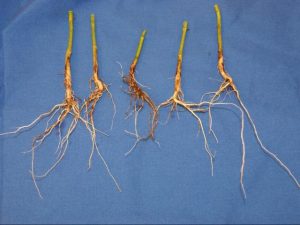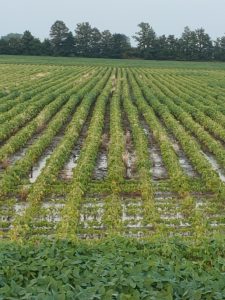Agronomy, Homepage Slider, Soybean Quality
How to Distinguish Flooding Injury from Phytophthora or Pythium Root Rot in Soybeans
By Dr. Anne Dorrance, adapted from C.O.R.N. 23-2021

Flooding injury occurs when soils are saturated for several days and anoxia develops. The roots are killed, as are the nodules that are home to the nitrogen fixing bacteria. The field has an “interesting’ smell but the key symptoms of this injury are on the roots. Dig up a few plants – if it is flooding injury the outside of the root – the epidermis will be easily pulled off the root leaving the white center – looks like rat tails. In addition, the nodules will be gray and easily crushed.
For Phytophthora stem rot – for those cultivars with low to moderate partial resistance ratings we will begin to see stem rot 5 to 10 days after the heaviest rains. On soybeans, a chocolate brown canker will develop, the plants will turn yellow, wilt and die. Cultivars with low ratings may lose as much as 50% of the stand. Where soils have been saturated but not submerged – this is a great year to check on those ratings.
Saturated soils promote infection from many of the watermolds – from our data over the past 15 years, there are more than 30 different species that cause root rots. If the soybean plants become infected with one of more of the watermolds – the roots will turn tan to dark brown and become soft.
Management during this season – this is time to be proactive for next year based on the data that you now have. Drainage is key to limit the losses from flooding, Phytophthora & watermolds.
- Documenting where the ponding occurred combined with the yield maps will help to pin point these areas to fix in the future.
- Does your resistance package work to Phytophthora – if the partial resistance levels are high then you should not see stem rot develop on these soybeans. Note every company has a different scale (i.e. 1 to 9 or a 9 to 1 scale) so read the fine print.
If left alone and not stressed more, many fields may recover (Figure 3). New roots will begin to form as soon as they can breathe again, new nodules will form and the plants will “catch-up”. I’ve had plants grow new roots during the time they were shipped in the mail to me.